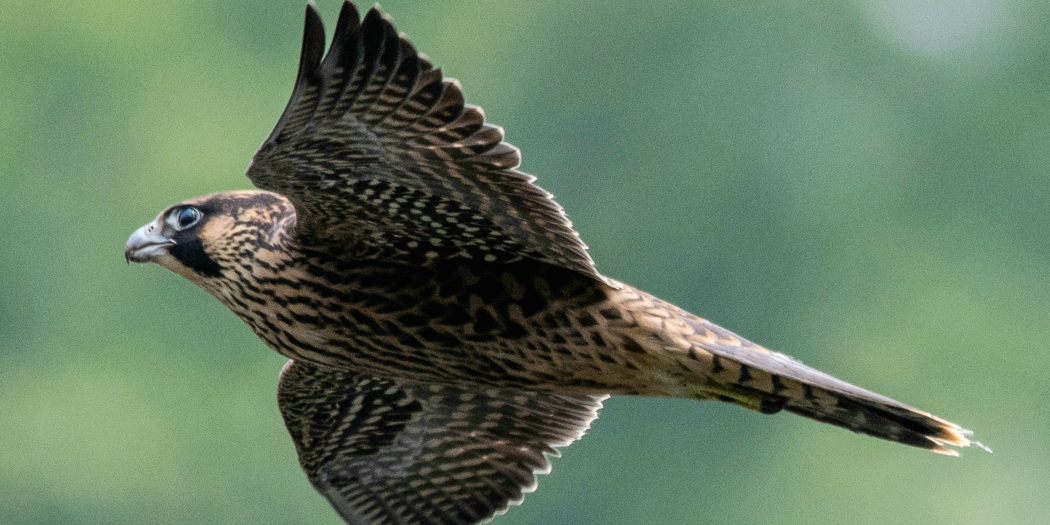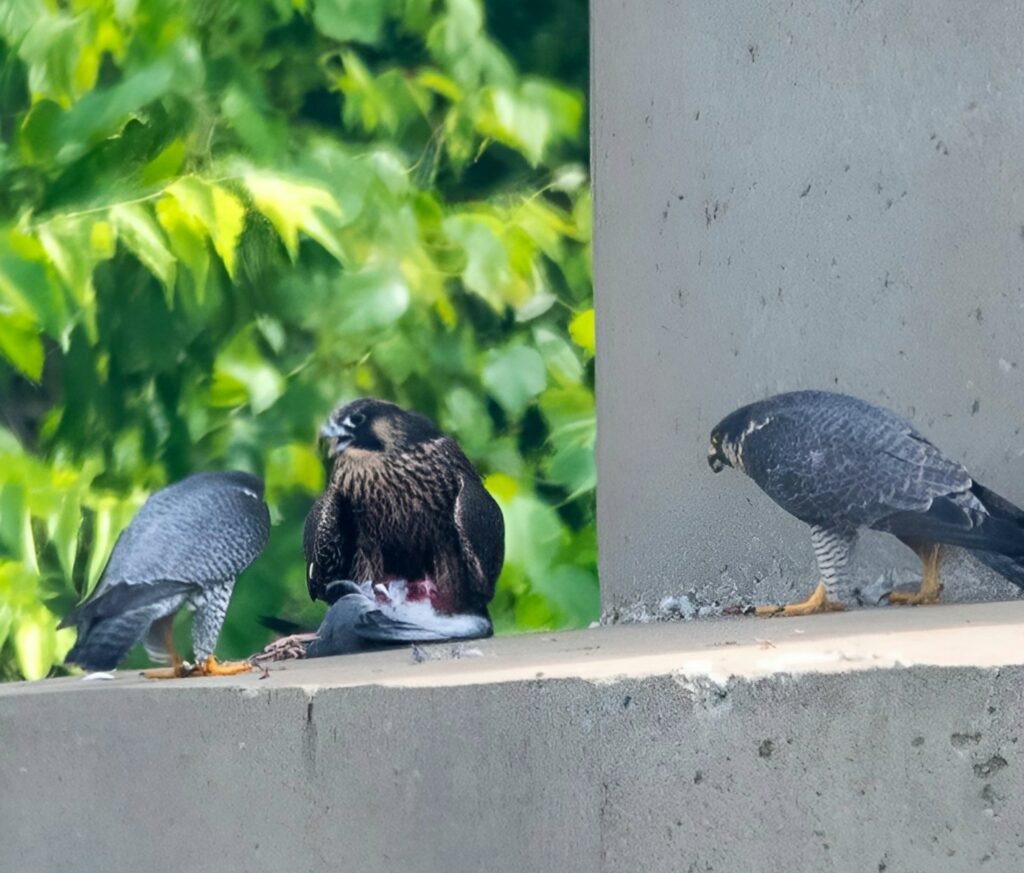Photography and article by Cindy Mullens
What would inspire the birders of Monongalia County to visit the bridges that pass over the Monongahela River? The locations are noisy with the hollow, high-pitched whine of cars and the intimidating rattle and shake of big rigs. How might such places draw the interest of people who usually roam remote swamps and largely unstructured wildlife management areas? Only the fastest animal on the planet.
Peregrine falcons were listed as a federally endangered species from 1970 through 1999. In the 1980s, the state began establishing peregrine nesting sites with the National Park Service, hoping the introduced falcons would return to those sites to breed. The program was reinitiated in the early 2000s to include the New River Gorge. The reintroduction sites included historical areas of peregrine nesting and bridges, as these had been successful nesting spots in other states. Now, the high-pitched, clear, loud calls of peregrines can be heard above traffic noise at a bridge in Monongalia County.
There is a difference between seeing an individual of a specific species and proving that reproduction is taking place. Individual peregrines, which are migratory in West Virginia, are seen in the state annually. Many are the introduced falcons from previous seasons. A successful breeding pair was not recorded in the state until 2021 at Harpers Ferry, where a reintroduction program sought to return the species to a historic nesting spot.
In 2018, a single peregrine falcon was observed in Morgantown. Not until 2022 were a pair of peregrines seen copulating in Morgantown on a bridge. Local birders were already making the bridge a regular stop in their birding tours to look for the peregrine falcon seen near the river, but no evidence of a nest was seen.
Bridge maintenance throughout the spring may have disrupted a nest. No young were seen on the bridge, though the adults stayed on through mid-summer, helping each other hunt. I observed that one falcon would station itself in hiding on one end of the bridge while the other waited opposite until the pigeons became lackadaisical about the presence of the falcons. The second bird would charge at the pigeons, driving them toward the waiting falcon.
I and other area birders again watched for falcons in the spring of 2023. The pair were spotted in April taking up residence on the bridge and mating soon after. Several birders and photographers visited the bridge in the following weeks, hoping to catch sight of the nest or fledglings.
Joe Hildreth, a local birder, sighted the nest and four fledglings on May 17. These were the first peregrine falcons on record to have produced a successful nest in Monongalia County.
Though it’s not known with certainty where they came from, the bridge on which they nested was not part of a reintroduction program. State ornithologist Rich Bailey suspects that they wandered in from the central Appalachians. Peregrine means “wanderer,” so perhaps it’s not unlikely that they found the location on their own.
In late May, the young birds were sighted again, away from the nest and learning to fly. Then, the most statistically likely tragedies befell two of the fledglings. One fell from the bridge and landed in the water—this is a common way for fledglings to die—but this fledgling had good luck when Johnny Yucha, fishing nearby, found her in the river.
A call was made to the Avian Conservation Center of Appalachia (ACCA), which accepted the young bird and determined her gender. She stayed with ACCA for several weeks, was banded by certified bander LeJay Graffious, and was successfully returned to the bridge in June.
Then a second, but no less miraculous, rescue occurred of a second fledgling. A trucker from Alabama reported a bird sitting along Route 79. Rescuers from ACCA again answered the call and picked up the fledgling. The volunteers rescued and rehabilitated this fledgling and returned it to the bridge in June.
I was at the bridge to see the first rescued fledgling released by ACCA veterinarian Jesse Fallon. The following days were worrisome as I was anxious to know whether the parents would accept the fledgling back under their protection, feed her and teach her to hunt. The challenge would be to see a band on her right leg—this would distinguish her from the young ones that had stayed with their parents.
On June 19, I witnessed a peregrine hunt taking place, with the parents in flight and a young one in chase, as they frightened pigeons from protected roosts. I could not capture a clear view of the young one’s leg.
On the next trip to the bridge, I found the adults hunting. They captured a pigeon but did not kill it. They deposited the injured bird on a bridge pier and called for the chicks. I could clearly see the leg band on a loudly-calling chick on this occasion. It was the river rescue baby since, at that time, there were no other banded peregrines at the bridge.
The young bird didn’t know how to kill the pigeon, so her parents helped her and gave her the body. She jealously guarded it and fought with her father when he came back to her and tried to take some of the prey bird. Perhaps to build her strength and sharpen her focus on how important it is to dispatch food quickly, both parents challenged their chick. The parents eventually took the pigeon’s body for their own consumption, much to the outrage of the young chick.
Later observations showed that the parents remain watchful of all of the chicks, often perching high in the beams. They left dead pigeons on piers and beams for the young but also engaged them in the process of hunting. With the second rescued chick returned to the bridge, it’s impossible to discern between the two rescued chicks. Still, the critical observation is that the parents accepted the rescued and rehabilitated chicks, fed them, and taught them to hunt just as the chicks that remained on the bridge.
Birders watching the training in July have noted that the parents are flying with the bodies of pigeons and pass the body to a chick in flight. This practice builds visual acuity, muscles used in flight, and an understanding of teamwork among the raptors. Soon these chicks may earn the regard of their species as the fastest animal on earth, but they need a lot of flight time and training before they can compete with adults.
The interest of area birders in the peregrine’s 2023 nesting season has also opened an opportunity to watch the fledging process and the long, arduous training the young undergo to learn to care for themselves. It also reinforced the importance of weaving the wild into developed areas for the purpose of preserving this once-endangered species.
Without ACCA, two of the chicks would have perished. According to A Season on the Wind by Kenn Kaufman, the rescue and rehabilitation of raptors, adults and young, played an important role in re-establishing the populations of eagles post-DDT. The same may be true today for peregrines, nesting on bridges. Every bird counts.
In Monongalia County, the opportunity to see a nest site and watch the young peregrines is compelling. Not only have people with a lengthy interest in birds been drawn to this rare opportunity, but the community has also been involved in watching out for the birds.
Sources:
Summary of information presented from:
https://www.nps.gov/hafe/learn/nature/peregrine-falcons.htm “Peregrine Falcons at Harpers Ferry”
Peregrine Falcon Program – New River Gorge National Park & Preserve (U.S. National Park Service) (nps.gov) “Peregrine Falcon Program


